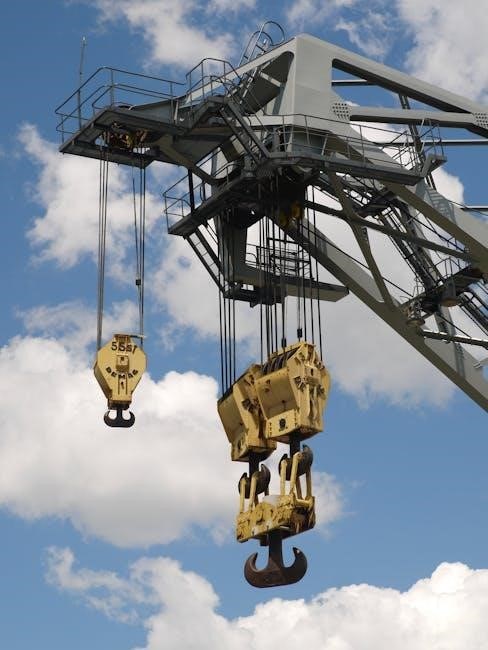The International Mechanical Code (IMC) is a model code that regulates the design, installation, and maintenance of mechanical systems. It ensures safety, efficiency, and compliance with industry standards.
1.1 Overview of the IMC
The International Mechanical Code (IMC) is a comprehensive model code that provides regulations for the design, installation, and maintenance of mechanical systems; It applies to residential, commercial, and industrial buildings, ensuring safety, efficiency, and compliance with industry standards. The IMC covers various mechanical systems, including HVAC, piping, and hydronics, offering detailed guidelines for proper system operation. By adhering to the IMC, professionals can ensure that mechanical systems are safe, energy-efficient, and meet local and international building codes.
1.2 Purpose and Scope of the IMC
The International Mechanical Code (IMC) is designed to safeguard public health, safety, and welfare by regulating the design, installation, and maintenance of mechanical systems. Its scope encompasses residential, commercial, and industrial buildings, ensuring mechanical systems operate safely and efficiently. The IMC provides minimum requirements for HVAC, piping, and hydronic systems, promoting consistency in enforcement and design practices worldwide. It serves as a foundational document for engineers, contractors, and code officials to ensure compliance with established safety and performance standards.
1.3 Importance of the IMC in Mechanical Systems
The International Mechanical Code (IMC) plays a crucial role in ensuring the safety, efficiency, and reliability of mechanical systems. By providing standardized guidelines, it minimizes risks associated with improper installations, reducing potential hazards such as gas leaks or system failures. Compliance with the IMC fosters consistency across jurisdictions, enabling engineers and contractors to design and install systems that meet universal safety and performance benchmarks. This adherence not only protects public health and welfare but also supports sustainable and environmentally responsible practices in the mechanical industry.

Key Sections of the International Mechanical Code
The IMC covers essential areas like HVAC systems, piping materials, and hydronic designs. It ensures safe mechanical system installations and operations across residential, commercial, and industrial settings.
2.1 Chapter 1: General Requirements
Chapter 1 outlines fundamental principles for mechanical system installations. It covers permits, inspections, and compliance with local regulations. This section ensures all systems meet basic safety and design standards, providing a foundation for more detailed specifications in subsequent chapters.
2.2 Chapter 2: HVAC System Requirements
Chapter 2 focuses on HVAC system installations, detailing requirements for heating, ventilation, and air conditioning. It includes standards for equipment, ductwork, and controls to ensure energy efficiency and indoor air quality. Compliance with these regulations is crucial for maintaining a safe and comfortable environment in both residential and commercial settings.
2.3 Chapter 3: Piping Systems and Materials
Chapter 3 provides detailed guidelines for piping systems, including materials, installation, and safety standards. It covers requirements for pipes, fittings, and joints to ensure durability and leak prevention. The section also addresses the use of appropriate materials based on fluid types and operating conditions, ensuring compliance with safety and environmental regulations. Proper adherence to these guidelines helps prevent failures and maintains system integrity in various mechanical applications.
2.4 Chapter 4: Hydronics
Chapter 4 focuses on hydronic systems, detailing requirements for design, installation, and maintenance. It covers components like boilers, heat exchangers, and piping networks. The section emphasizes safety measures, such as pressure testing and corrosion protection, to ensure reliable operation. Guidelines for fluid selection and system controls are also provided to optimize performance and energy efficiency. Compliance with these standards is crucial for preventing failures and ensuring long-term functionality of hydronic systems in various applications.
How to Download the International Mechanical Code PDF
To obtain the IMC PDF, visit official sources like the International Code Council website or third-party platforms offering free downloads. Ensure reliability by following verification steps and complying with safety standards.
3.1 Official Sources for IMC PDF
The International Code Council (ICC) website is the primary official source for downloading the IMC PDF. It offers the most accurate and up-to-date versions, ensuring compliance with safety standards. Additionally, ICC provides supplementary materials like commentaries and interpretations. Other official sources include government websites and recognized publishing platforms that distribute ICC codes. These sources guarantee authenticity and reliability, making them the preferred choice for professionals and regulators seeking the IMC PDF.
3.2 Third-Party Websites for Free Downloads
Several third-party websites offer free downloads of the International Mechanical Code PDF, providing convenient access for users. These platforms often include forums, repositories, and sharing sites where the IMC is available. However, users must exercise caution to ensure the downloaded version is accurate and up-to-date. Verification through official sources is recommended to avoid outdated or modified content. While these sites can be helpful, reliance on official sources is always advised for legal and compliance purposes.
3.3 Steps to Ensure a Reliable Download
To ensure a reliable download of the International Mechanical Code PDF, verify the source’s credibility and check for the latest edition. Use secure connections to prevent data breaches. Scan the file for malware before opening. Ensure the PDF is complete and unaltered. Cross-reference with official updates to confirm accuracy; Avoid unofficial sources that may provide outdated versions. By following these steps, users can securely obtain a reliable copy of the IMC for compliance and reference purposes.

Benefits of Referencing the IMC
Referencing the IMC ensures compliance with safety standards, provides design guidance, and helps maintain code adherence, ultimately enhancing the performance and reliability of mechanical systems.
4.1 Compliance with Safety Standards
The IMC establishes foundational safety standards for mechanical systems, ensuring the protection of people, property, and the environment. By adhering to the IMC, professionals can guarantee that installations meet rigorous safety requirements, reducing risks associated with improper design or execution. The code addresses materials, design, and installation practices, providing clear guidelines to prevent hazards. Compliance with these standards is legally mandated in many jurisdictions, ensuring a uniform approach to safety across regions. This adherence fosters trust and reliability in mechanical systems worldwide.
4.2 Guidance for Mechanical System Design
The IMC provides comprehensive guidance for designing mechanical systems, ensuring they are safe, efficient, and meet regulatory requirements. It outlines design principles, material specifications, and installation methods to support engineers and contractors. The code addresses ventilation, heating, cooling, and piping systems, offering detailed criteria for system performance. By following IMC guidelines, professionals can ensure optimal functionality while adhering to safety and energy efficiency standards. This makes it an essential resource for modern mechanical system design, promoting innovation and sustainability in construction projects.
4.3 Ensuring Code Compliance in Construction
Ensuring code compliance in construction involves adhering to IMC standards throughout the project lifecycle. Regular inspections, testing, and documentation are essential to verify that mechanical systems meet safety and efficiency requirements. Compliance ensures legal adherence, reduces liability risks, and promotes public safety. By following IMC guidelines, professionals can avoid costly rework and delays. Proper training and staying updated on code revisions are crucial for maintaining compliance. This proactive approach fosters trust and confidence in the construction process, ensuring reliable and sustainable mechanical systems.
Applications of the International Mechanical Code
The IMC applies to residential, commercial, and industrial mechanical systems, ensuring safety and efficiency in HVAC, piping, and hydronics. Its guidelines are universally adopted.
5.1 Residential Mechanical Systems
The IMC provides essential guidelines for residential mechanical systems, including HVAC, piping, and hydronics. It ensures safe and efficient installation, maintenance, and operation of these systems in homes.
5.2 Commercial Mechanical Systems
The IMC offers comprehensive guidelines for commercial mechanical systems, addressing HVAC, piping, and hydronic installations tailored to larger, more complex environments. It ensures safety, efficiency, and scalability in commercial buildings, providing detailed requirements for system design and operation. The code also covers specific challenges in commercial settings, such as varied load demands and energy efficiency standards, ensuring systems meet both regulatory and performance expectations. Compliance with the IMC is crucial for maintaining safe and reliable mechanical operations in commercial spaces.
5.3 Industrial Mechanical Systems
The IMC provides detailed regulations for industrial mechanical systems, focusing on high-performance and safety-critical applications. It addresses unique challenges such as heavy-duty machinery, hazardous materials, and large-scale operations. The code ensures that industrial systems are designed to withstand extreme conditions while maintaining efficiency and compliance. Specific provisions cover piping, HVAC, and hydronic systems tailored to industrial environments, ensuring operational reliability and adherence to safety standards. Proper IMC compliance is essential for minimizing risks and optimizing performance in industrial settings.

Understanding the Structure of the IMC
The IMC is organized into chapters and sections, providing a clear framework for mechanical system regulations. Its table of contents and appendices simplify navigation and reference.
6.1 Table of Contents and Organization
The IMC features a comprehensive table of contents that organizes its regulations logically. It is divided into chapters covering general requirements, HVAC systems, piping, and hydronics. Each chapter contains specific sections, making it easy to locate relevant information. The table of contents is designed to guide users through the document efficiently, ensuring quick access to key topics. This clear organization enhances the usability of the code, making it a valuable resource for professionals and stakeholders involved in mechanical system design and installation. The structured format ensures that all aspects of mechanical systems are addressed systematically, promoting consistency and compliance.
6.2 Appendices and Reference Materials
The IMC includes detailed appendices that provide supplementary information and guidelines. These appendices offer calculations, diagrams, and examples to support compliance with the code. They address specific topics like piping materials, ventilation rates, and safety standards. Reference materials within the appendices are crucial for professionals to ensure accurate and safe installations. These additional resources enhance the code’s practical application, making it an indispensable tool for engineers, contractors, and inspectors. The appendices are regularly updated to reflect the latest industry practices and technological advancements, ensuring relevance and effectiveness in the field. This comprehensive approach underscores the IMC’s commitment to fostering safe and efficient mechanical systems.
6.3 Updates and Revisions in Recent Editions
Recent editions of the IMC incorporate updates to align with technological advancements and industry needs. These revisions include enhanced provisions for energy efficiency, updated safety standards, and expanded guidelines for emerging technologies. Changes address specific areas like piping materials, HVAC system design, and hydronic heating requirements. The updates aim to improve system performance, reduce environmental impact, and ensure compliance with modern safety protocols. Professionals are encouraged to review these revisions to stay informed and adapt their practices accordingly, ensuring optimal outcomes in mechanical system installations and operations.
Importance of Code Compliance
Adhering to the IMC ensures mechanical systems operate safely, efficiently, and legally, protecting public health and reducing risks of accidents and legal penalties.
7.1 Legal Requirements for Compliance
Compliance with the IMC is legally mandated for all mechanical systems in jurisdictions adopting the code. Adherence ensures systems meet minimum safety standards, protecting public health and safety. Legal requirements enforce proper design, installation, and maintenance practices, reducing risks of accidents and legal penalties. Authorities conduct inspections to verify compliance, and violations can result in fines or system shutdowns. Staying updated with IMC revisions is crucial to avoid legal issues and ensure continuous compliance.
7.2 Safety Benefits of Code Adherence
Adhering to the IMC ensures mechanical systems operate safely, reducing risks of accidents and hazards. The code sets standards for design, installation, and maintenance, protecting public health and safety. Compliance minimizes potential dangers such as gas leaks, fires, and system failures. By following IMC guidelines, mechanical systems function reliably, safeguarding occupants and property. Regular inspections and updates to the code further enhance safety, addressing emerging risks and technological advancements. This ensures a safe environment for residential, commercial, and industrial settings.
7.3 Environmental Impact of Code Compliance
Compliance with the IMC promotes environmental sustainability by ensuring efficient mechanical systems. The code mandates standards that reduce energy consumption and emissions, fostering eco-friendly practices. Proper installation and maintenance of systems minimize waste and resource depletion. Additionally, adherence to IMC guidelines supports the use of renewable energy sources and green technologies. By aligning with environmental regulations, the IMC helps reduce the carbon footprint of buildings, contributing to a healthier planet. This emphasis on sustainability is crucial for long-term environmental protection and resource conservation.

Interpretations and Updates to the IMC
The IMC undergoes regular updates to address emerging technologies and industry needs. Official interpretations ensure clarity and consistency in code application, while updates reflect modern advancements.
8.1 Official Interpretations of the Code
Official interpretations of the IMC provide clarity on ambiguous provisions, ensuring consistent application. These interpretations are developed by code authorities and address specific questions or disputes. They are essential for resolving conflicts and guiding compliance. By referencing official interpretations, professionals can better understand and apply the code, reducing risks and ensuring safety. Regular updates and interpretations keep the IMC aligned with industry advancements and regulatory requirements, fostering a safer and more efficient mechanical system environment.
8.2 Recent Updates and Amendments
Recent updates to the IMC address emerging technologies, safety standards, and environmental considerations. Amendments include revised requirements for energy efficiency, updated testing protocols, and new provisions for alternative fuel systems. These changes reflect advancements in mechanical systems and align with global sustainability goals. Professionals are encouraged to review the latest editions to ensure compliance and incorporate best practices. Regular updates ensure the IMC remains relevant and effective in regulating mechanical systems for safety and performance.
8.3 How to Stay Informed About Changes
Staying informed about IMC updates requires proactive engagement. Subscribe to official newsletters, attend webinars, and follow industry forums. Regularly visit the International Code Council (ICC) website for the latest editions and summaries of changes. Participate in training sessions and workshops focused on code updates. Utilize online resources and reference materials to stay current. By maintaining awareness of revisions, professionals can ensure compliance and apply the most up-to-date standards in their work, fostering safety and innovation in mechanical systems.

Resources for Understanding the IMC
Access training programs, workshops, and online courses to deepen your knowledge of the IMC. Utilize reference materials and guides for comprehensive understanding and practical application.
9.1 Training Programs and Workshops
Enroll in specialized training programs and workshops designed to interpret and apply the IMC effectively. These sessions cover code updates, compliance strategies, and practical implementation techniques. They are conducted by industry experts and provide hands-on experience. Many programs offer certifications, enhancing professional credentials. Workshops often include case studies, group discussions, and interactive exercises to ensure a comprehensive understanding of the code. Regular updates in the curriculum keep participants informed about the latest changes and advancements in mechanical systems regulation.
9.2 Reference Materials and Guides
Supplement your understanding of the IMC with authoritative reference materials and guides. Textbooks, such as those by F Katamba, provide foundational insights into technical language and communication. Detailed handbooks and companion guides, like those by Francis D.K. Ching, offer practical explanations of mechanical systems. Online resources, including step-by-step guides, cater to diverse learning needs. Additionally, AI-powered tools like OpenAI’s GPT models can assist in analyzing complex code sections, while resources from Booking and Atom bank offer insights into compliance and verification processes. These materials ensure a comprehensive grasp of the IMC.
9.3 Online Courses and Tutorials
Enhance your knowledge with online courses and tutorials tailored to the IMC. Platforms like Coursera and Udemy offer courses on mechanical systems and construction codes. The ICC provides official training programs for professionals. These resources include hands-on exercises and expert guidance, helping you interpret and apply the IMC effectively. Additionally, AI tools like OpenAI’s GPT models can aid in understanding complex code sections, while step-by-step guides from platforms like Booking and Atom bank offer practical insights. These educational resources complement the IMC PDF, ensuring comprehensive understanding and effective application.
The IMC is a critical resource for ensuring safety and compliance in mechanical systems. Referencing it guarantees adherence to industry standards and best practices, promoting efficient and safe designs.
10.1 Summary of Key Points
The IMC provides comprehensive guidelines for mechanical systems, ensuring safety, efficiency, and compliance. It covers installations, materials, and designs, offering a framework for both residential and commercial applications. By adhering to the IMC, professionals can avoid legal issues and ensure systems operate safely. The code is regularly updated to reflect technological advancements and industry needs, making it an essential resource for engineers, contractors, and architects. Accessing the IMC PDF is crucial for staying informed and compliant with current standards.
10.2 Final Thoughts on the Importance of the IMC
The IMC serves as a universal standard for mechanical systems, ensuring safety, efficiency, and compliance. Its guidelines are essential for engineers, contractors, and architects to design and install systems correctly. By adhering to the IMC, professionals can prevent hazards, optimize performance, and stay aligned with industry best practices. As a foundational document, it supports innovation and sustainability in mechanical engineering. Encouraging its adoption and regular updates ensures the IMC remains a vital resource for the industry.
10.3 Encouragement to Download and Use the IMC
Downloading and using the IMC is essential for ensuring compliance with safety and design standards. It provides clear guidelines for mechanical systems, helping professionals avoid hazards and optimize performance. By referencing the IMC, engineers, contractors, and architects can ensure their projects meet legal and industry requirements. Staying updated with the latest edition guarantees access to the most current practices and standards. Encourage your team to utilize the IMC for efficient, safe, and compliant mechanical system design and installation.
